- Compact style
- Indico style
- Indico style - inline minutes
- Indico style - numbered
- Indico style - numbered + minutes
- Indico Weeks View
PS/SPS User Meeting
PS-SPS Users Meeting for Week 22 held on May 30th, 2024
Physics Coordination schedule:
- May 19th to June 9th: Martin Jäkel
- June 10th to June 20th: E. Barbara Holzer
- June 21th to July 7th: Martin Jäkel
- July 8th onwards: E. Barbara Holzer
June 13th: User meeting exceptionally on zoom only (for availability of the conference room).
News from the PS & SPS Physics Coordinator
E.B. Holzer, M.R. Jäkel
Today 30.05 : SPS Magnet exchange on Thursday, no beam from Thursday 8h00 to Friday late morning
-
User Schedules v2.0.1 (for most of the lines until end of August) released: see User Webpage
-
Please get in contact, if you want to take one of the week still free before June - Tanja (tetiana.shulha@cern.ch) is collecting all requests. Newly available : Week 22 in H2. (In parallel with NA64, high energy hadrons and low energy electrons (< 120 GeV/c) of good quality)
-
2024 injector schedule released EDMS 2872566
2024 approved LHC schedule EDMS 2872429
Proton Run 2024
- AD/ELENA Physics Stop Monday 02.12.2024
- SPS NA Physics Stop protons Thursday 31.10.2024
- PS EA Physics Stop protons Wednesday 27.11.2024
Ion Run 2024
- SPS NA Physics Start 4.11.2024 (maybe earlier if set-up is fast) - Stop Pb ions Monday 2.12.2024 (6h)
- NA : Week 45-47 high energy
- NA : Week 48 low energy (no LHC running)
- PS EA Physics Start 6.11.2024 (tbd) - Stop Pb ions Monday 2.12.2024 (6h)
- CHIMERA: 13.11-2.12
Reminder: Beam time exceeding the limits of 2 weeks PS beam time and 1 week SPS beam time (added proton and ion beam time!) per year need the approval of one of these CERN committees: SPSC, LHCC, DRDC, INTC, RB or IEFC. Consider joining a DRD collaboration, if you require more beam time.
News from the Facilities Operations Meeting (FOM) (M.R. Jäkel)
Upcomming MDs:
- Week 22: Dedicated: 29/5 → COLDEX (no extraction to TT20)
Long parallel: 30/5 → continue LIU emittance optimization - Week 23: no dedicated MDs
- Week 24: start of first Injector Technical Stop
(ITS3)
Upcoming Techncial Stop
- 12-15.06 : Intervention on Swiss power network. (Planed to finish Friday, with Sat. 15.06 as overflow day)
- Not the main supply for CERN, but electrical pertubations (high harmonic distortions) likely. Risk of trips on SVCs and filters for LHC and injectors.
- TI will confirm the end of the interventions and give go-ahead for restart
PS Machine Report (Denis Cotte)
-
Good availability 94% overall for the PS this week despite several beam stops.
- RF Systems Issues: Problems with the relay gap C10-51 on Thursday were fixed by RF experts.
-
Electrical Glitch on Sunday:
- Many systems tripped across the complex
- Most downtime on T8 (quad required first line)
- RF systems trip (coarse tuning) came back rapidly
- Important effort from PS OP to restart AD.
-
Beam Interruptions: Several interruptions yesterday morning due to POPS-B trips caused by a false floor opening interlock.
-
Resynchronization needed: KFA45 (injection kicker) modules needed resynchronization, taking 1 hour.
-
Beam Preparation: Beam prepared for EAST T9 with a longer spill at 15 GeV.
- RFKO Extraction Test: Conducted last Tuesday.
-
Follow-up on potential changes to PSB B train explaining issues from last week for orbit at injection
SPS Machine Report (Stephane Cettour cave)
Plan for the week and next
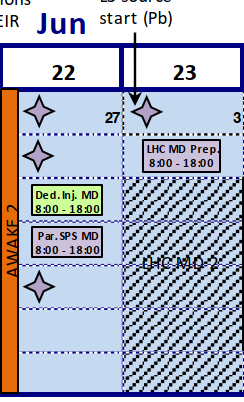

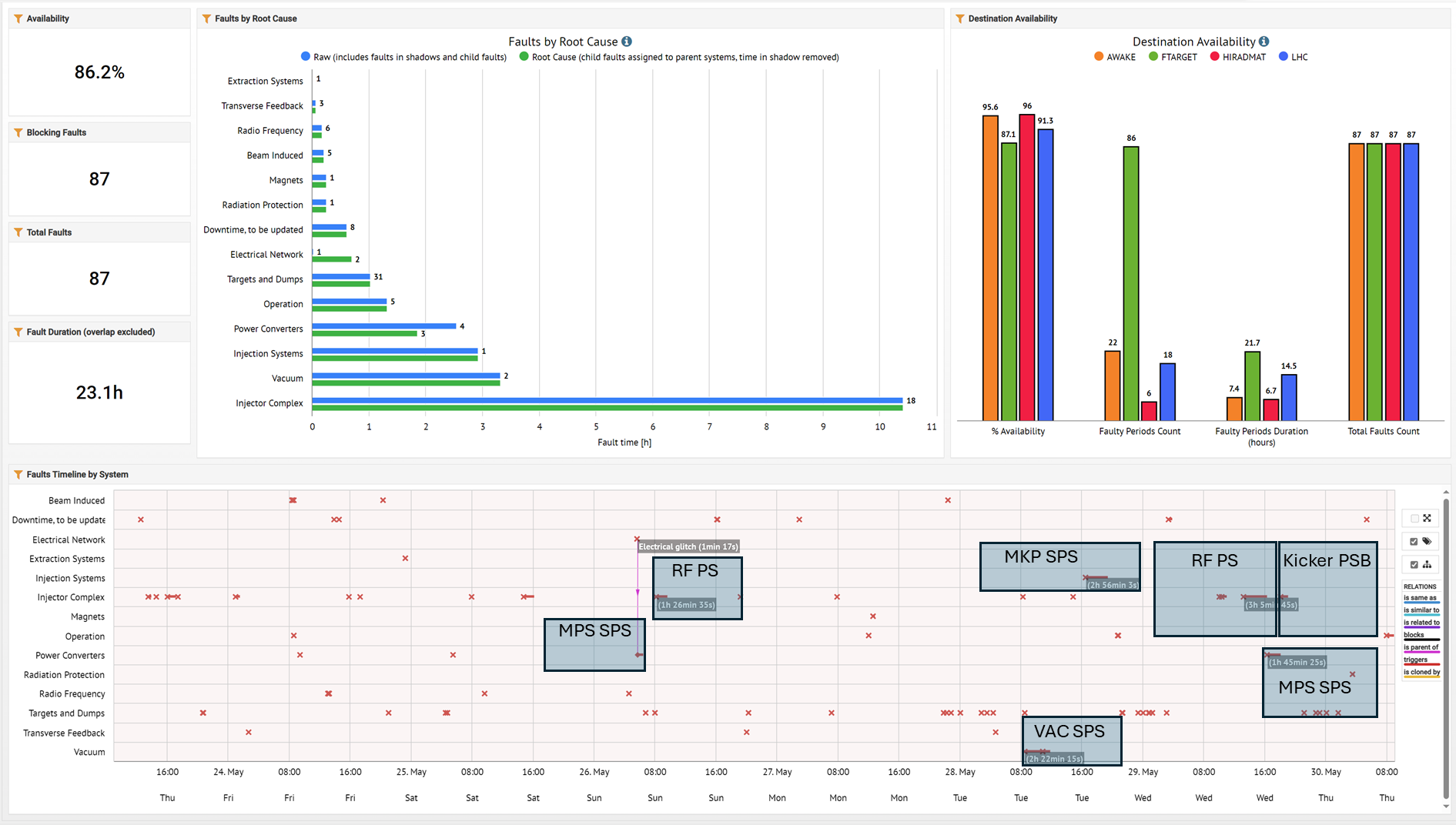
-
Overview of end of last week
- Fixed target running with no major problems.
- ZS girder had to be realigned due to increased losses
- change of position compatible with last year changes
- TECS re-aligned too to follow the change of ZS girder
- AWAKE physics run started on Monday
- nominal bunch length obtained after changing the voltage balance on cavities to reduce load on cavity 3 (as C1 was now back)
- Fixed target running with no major problems.
-
Status of this week
- Fixed target relatively stable
- We found the source of problem which created the spikes on the extraction spill
- It came from the FGC output DAC and the EPC expert investigating to remove this features
- AWAKE working fine
- On Tuesday morning vacuum leak detction needed on BA6
- Problem detected on Magnet MBA.63450
- From Thurday at 8h00 to Friday at ~12h00 Magnet change
- Friday afternoon beam should be back
- Fixed target relatively stable
Safety (A. Schouten)
- General reminder for ISIEC requests.
nToF (M.Bacak and P.M.Milazzo)
Data taking on:
- EAR1: Ce(n, f)
- EAR2: End of 146Nd(n, g)
- EAR2: 28,29Si(n, g) started on 29.05
Few issues due to elecrical instabilities on 26.05.
HpGe detector in NEAR has changed and activation measurement will restart tomorrow (31.05).
Beam in standard conditions.
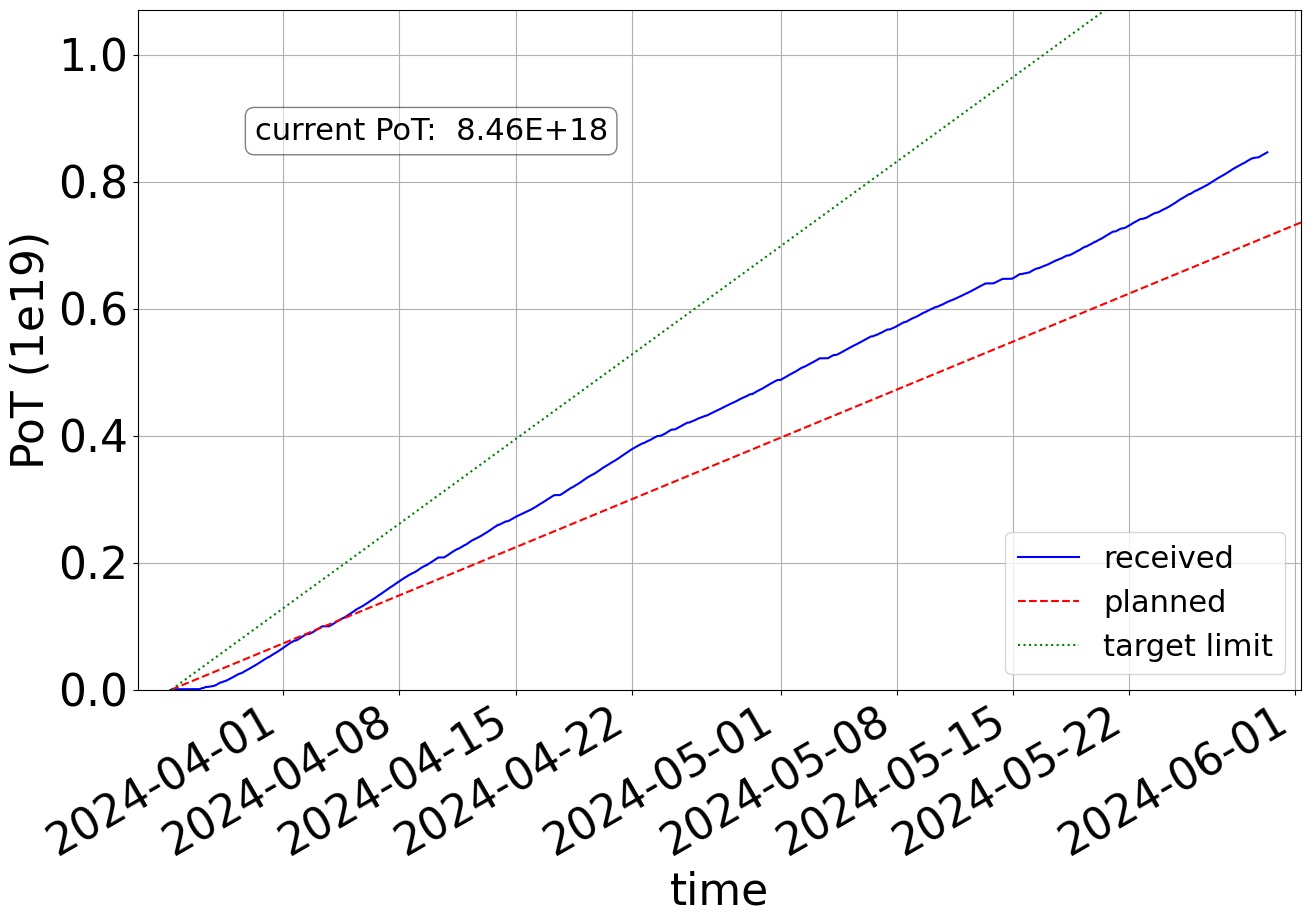
East Area Beam Status (M. van Dijk)
T09: Good operation. No major issues.
T10: Mostly good operation, some issues with magnet T10.BHZ.027, addressed by experts, should be more stable now.
T11: No operation.
East Area Users Tour de Table
T8 Main: IRRAD/CHARM (S. Fiore / F. Ravotti)
Regular user operation. Good week: cumulated ~2.8e16 p/w and reached CHARM TID target, see plot below. We reduced the intensity on Monday morning to test cool-down scheme for CHARM. Data being evaluated to decide how to proceed next week. Beam centering very good (center within +/- 2mm >92% of the time).
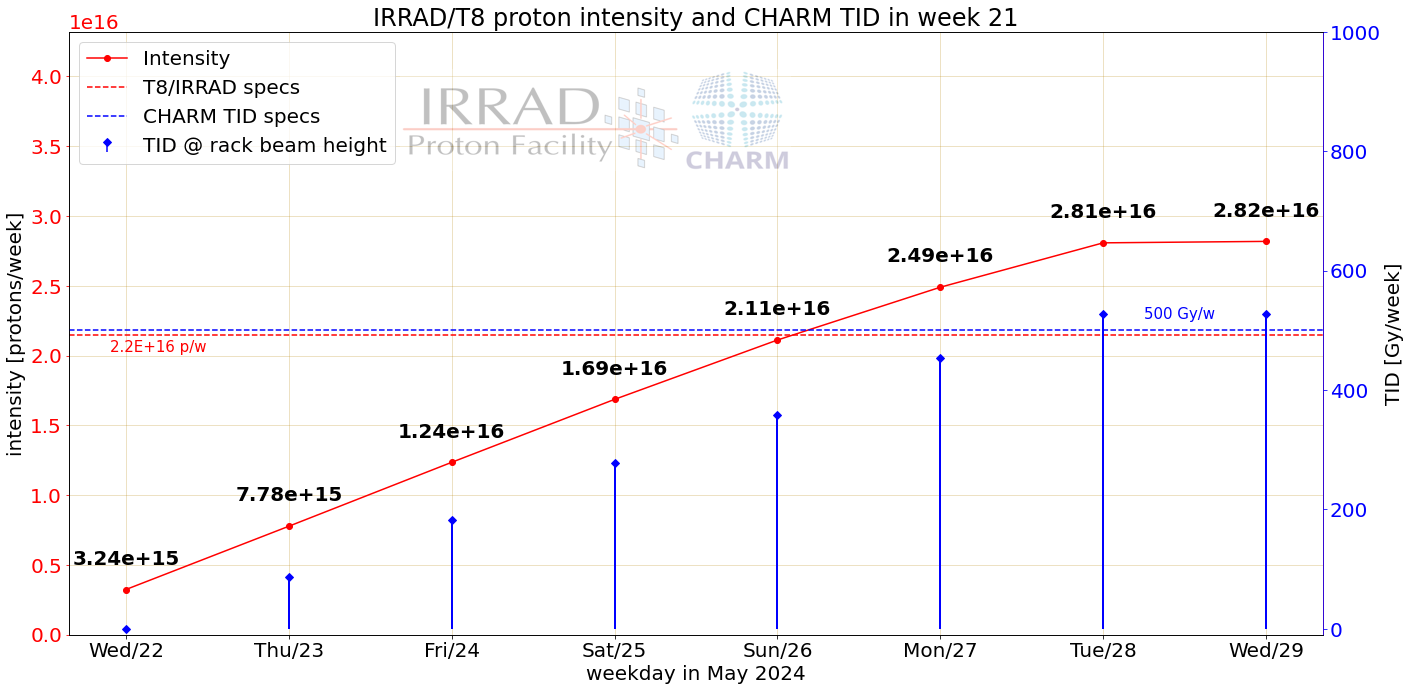
Access during Wednesday morning. In IRRAD exchanged samples for TE-MSC experiment, and irradiations for ATLAS-HGDT performed over the week. All other long-term experiments continue. In CHARM full rack swap with new setups by CMS and BE-CEM. We continue until next Wednesday. On Tuesday morning after 9am, planning some hours of beam steering and measurement with Marc/Eliott.
T9 Main: VLAST (LI Xiang)
The beam availability is very good. The magnet was down for a few times but fixed by experts soon.
Gamma-ray is an important observation object for VLAST (Very Large Area gamma-ray Space Telescope). And we have been carrying up several tasks:
- Calorimeter calibration with muons;
- Electron beam taking from 1 to 5 GeV;
- User magnet calibration with electrons and muons;
- Gamma-ray (induced by electron) data taking.
A few figures from our analyses:
-
User magnet calibration
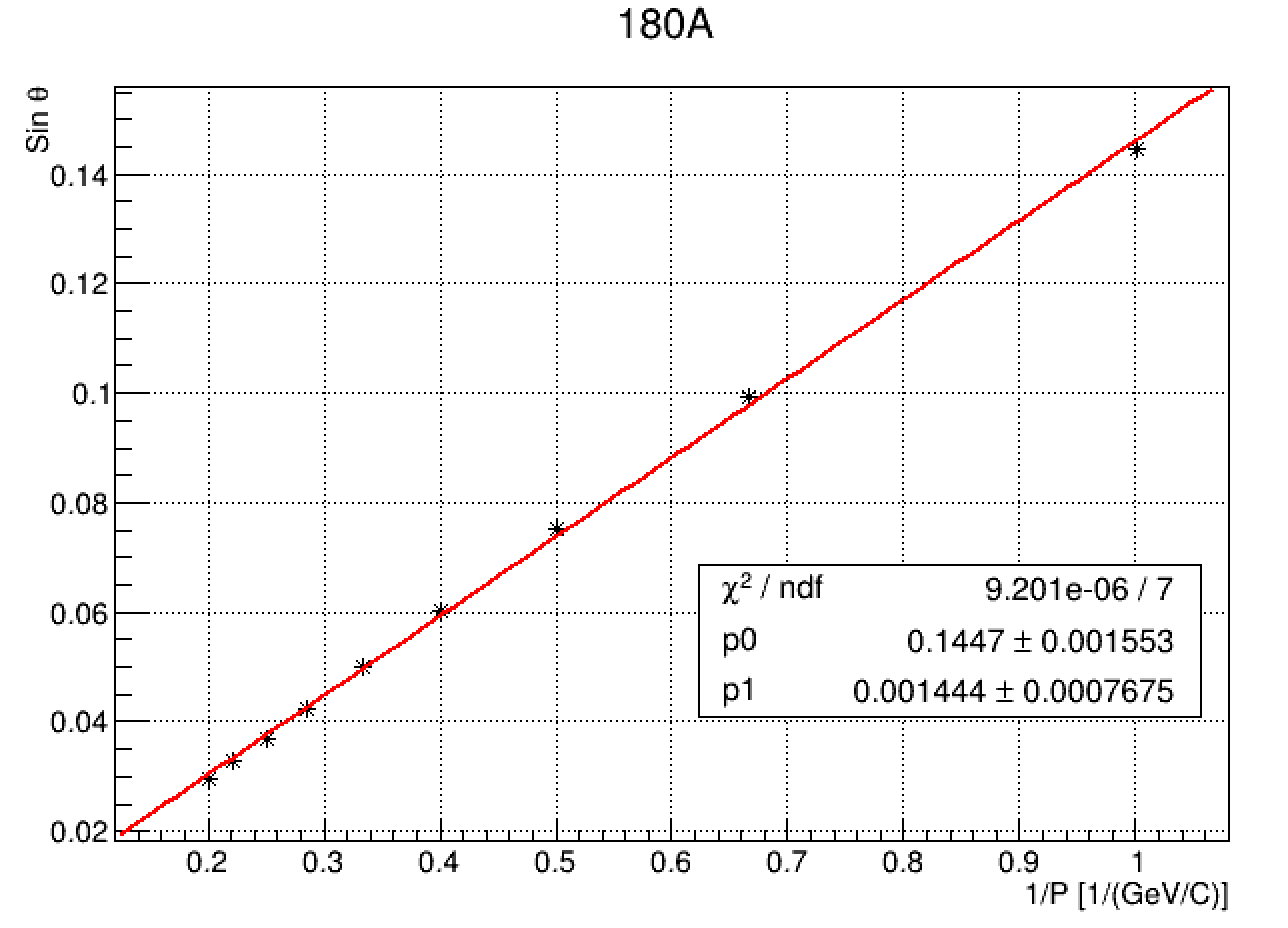
-
Gamma-rays from electron beam
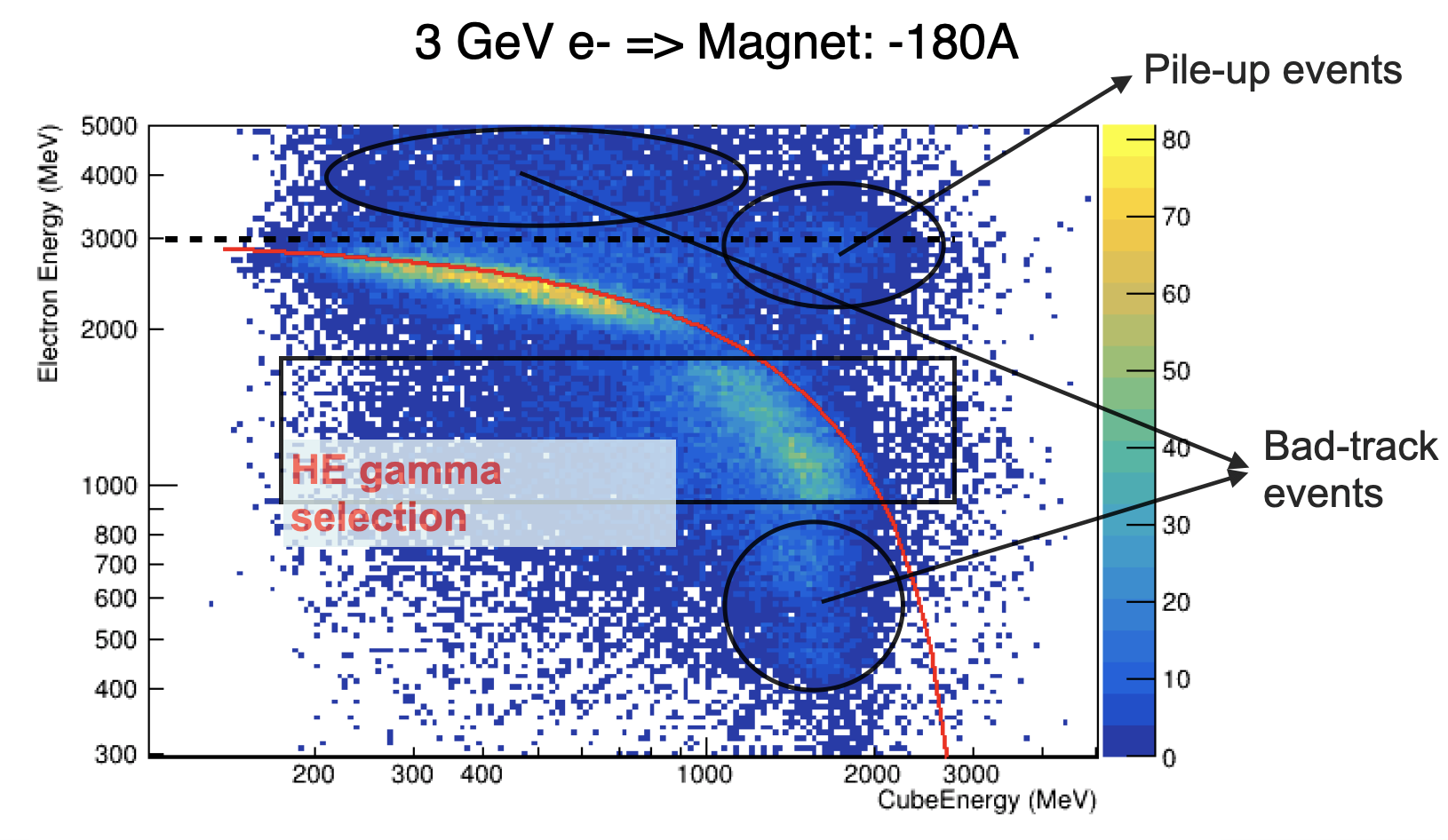
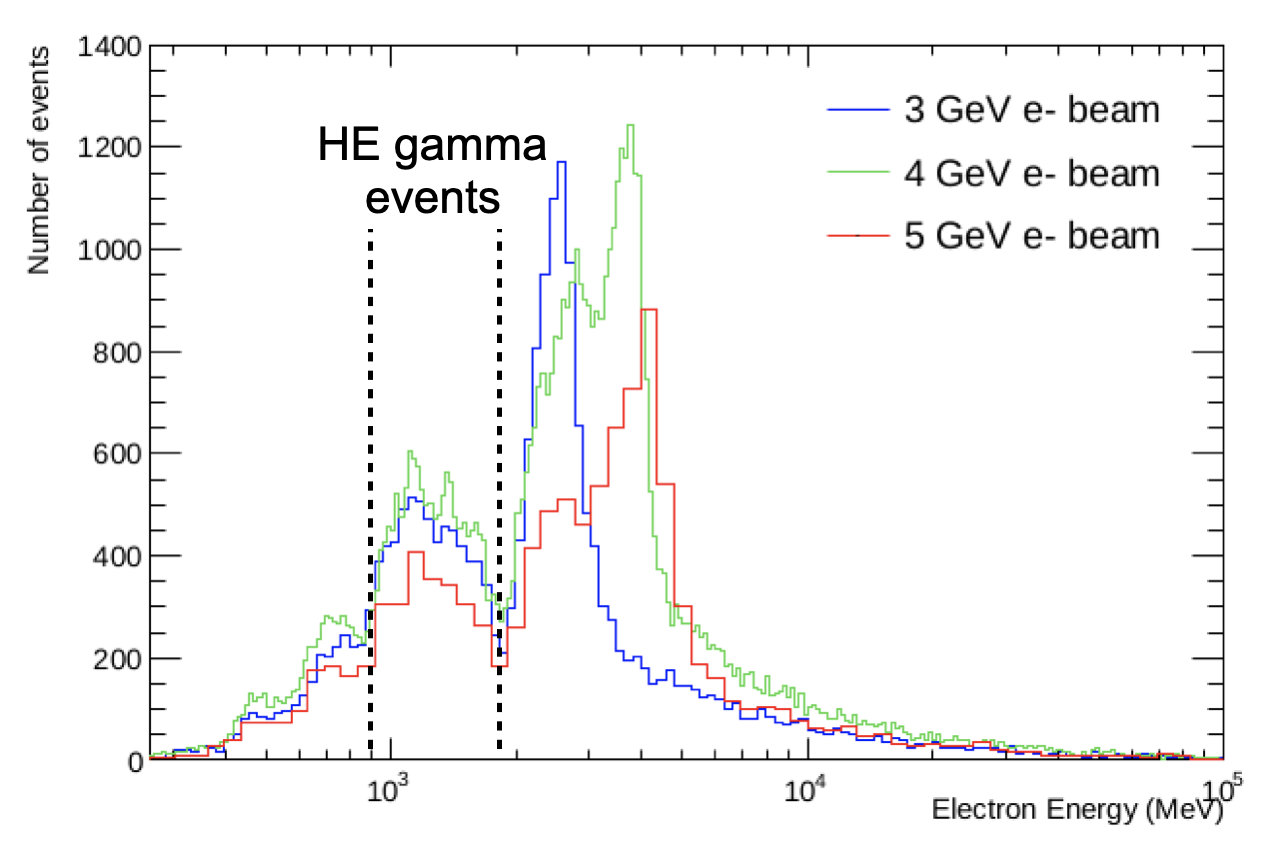
We are still accumulating the statistics.
Thank you for the good beam, and thanks to Dipanwita for the beamfiles.
T9 Incoming Main: E+BOOST - Week 23 (S. Carsi)
Installation
- Starting Wednesday June 4th at 8.00 a.m.
- Installing all our particle detectors, including two silicon microstrip beam chambers, the crystals under test and an electromagnetic calorimeter
- The CERN staff will take care of installing a bending magnet inside the area, a XSCA and a Desy table
Sketch of setup layout

What is needed from the CERN Staff
- Screws for fixing the first beam chamber (see presentation)
- The bending magnet, to be installed about 7 m from the end of the beamline, we can discuss directly during the installation day
- Both Cherenkov detectors with cable signals directly inside the experimental area
- Desy table and XSCA table
- The extra manual table, to be installed at the end of the beamline
- A regular rack for installing NIM & VME Crates
- A couple of ordinary tables for installing the DAQ PC
- Few rubber glands for routing cables inside experimental area
- Few Iron bricks, 10 cm in one size, for supporting our EM Calorimeter (see a pic in the presentation)
Measurement plan
Once the setup in installed, we will
- Aling all the detectors wrt the beam
- Plance and center the crystal samples wrt the beam
- Equalize and calibrate our calorimeter using different momenta beams
- We can then start with our Physics program
Thanks
A special thanks to all the CERN Staff, especially to Dipanwita and Aboubakr for their kindness and availability to find the best solutions for us.
T10 Main: EIC dRICH (Please Put Your name here)
T10 Incoming Main: ALICE ITS3 - Week 23 (Paolo Martinengo)
preparing set-up in the lab, no special needs/requests
T10 Incoming Parallel: ALICE FOCAL - Week 23 (Please put your name here)
User will not take beam during week 23.
TODO: update the schedule accordingly.
North Area Beam Status (M. van Dijk)
General:
H2: Smooth operation.
H4: Smooth operation.
H6: Good operation.
H8: Good operation, some access issues with patrol on PPE148, solution to be identified.
M2: The quad9 fluctuations are now corrected following an EPC intervention on Monday. Otherwise good operation.
P42/K12: Smooth operation. Patrol lost in ECN3, kind reminder to be careful because the re-patrol involves a lot of persons and corresponds to time lost.
AWAKE (M. Bergamaschi)
| M | T | W | Th | F | S | S | M | T | W | Th | |
|---|---|---|---|---|---|---|---|---|---|---|---|
| SPS extractions | 332 | 789 | MD | MD | 706 | 810 | 707 | 826 | 484 | MD | Stop |
| Hours of beam to AWAKE extraction | 2.1 | 6.5 | MD | MD | 5.9 | 5.0 | 4.6 | 6.5 | 3.6 | MD | Stop |
| Hours of interuption during AWAKE extractions | 0.3 | 2.1 | MD | MD | 2.9 | 3.6 | 0.0 | 0.6 | 0.5 | MD | Stop |
Detailed program:
- Monday: Diagnostics checks. 1e11 p /bunch, bunch length on the streak camera of 200ps longer than usual 170ps.
- Tuesday: Limited extractions due to a PS cavity that needed an access. After solving the PS cavity problem and thanks to SPS Rf experts works managed to get back to the usual bunch length size 170ps rms
- Wednesday: Access to add a camera and collimator for density diag, marker laser line alignment and attenuation
- Thursday: Access for schlieren alignment and plasma diag checks, frequency divider replaced for decreased time jitter from 10ps to 5ps on streak images
- Friday: Studies at proton bunch intensities of 1e11 p/bunch
- Saturday: Studies at proton bunch intensities of 3e11 p/bunch, number of extraction to AWAKE was limited by an LHC fill, a problem in the PS cooling and a test for LHC injection on SPS side
- Sunday: Studies at proton bunch intensities of 3e11 p/bunch. Morning no requested extraction to SPS as plasma source was not ready as it had to cooldown
- Monday: Studies at proton bunch intensities of 3e11 p/bunch and 1.5e11 p/bunch.
- Tuesday : Leak detection in SPS in the morning, afternoon studies at proton bunch intensities of 3e11 p/bunch. Interupted because of MKS problem that needed an access
North Area Users Tour de Table
P42-K12:
NA62 (Phil Rubin)
We enjoyed a very productive weekend, thanks to a remarkably high accelerator duty factor and good beam quality, which unfortunately halted with the leak detection access. We lost 4 hours this morning after a fault in a K12 bend magnet. We are presently in standby mode, with some detector voltages off. We will patrol and close access to the area this evening and patrol the area in the morning.
We believe we have isolated and mitigated the source of noise in our trigger system which has caused us to lose ~2% of events that otherwise pass all our trigger requirements.

M2:
Main: AMBER (Thomas Poschl)
- Quad9 issue solved
- reduction of intesity for physics run to 30 units on T6
- safety checks of target ongoing
- final preparations of target for physics run started
- beam tuning for physics run planned for this week
- Reminder: In case of access or work in/on the experimental hall, please contact Benjamin Moritz Veit (TC) 161821, b.veit@cern.ch. With start of Hydrogen operation several safety regulations have to be respected!
H2:
Outgoing Main: ALICE FOCAL (T.Isidori, R.Simeonov)
- 2 readout systems were successfully tested and verified to evaluate the detector performance:
-
CAEN DT5202:
- Dedicated pedestal runs were taken before beam runs
- Synchronisation in the boards was improved due to the usage of DT5215 concentrator board
- Detailed position scans - more points than before!
- Dedicated compensation runs - ongoing analysis (also with MC)
- At first look at the analysis, the saturation in the electronics seem less than in previous TBs
-
H2GCROC3:
- Two boards were installed and tested for the first time!
- Analysis software developed during TB
- Various tests performed and the data looks promising
- Analysis ongoing
-
Incoming Main: ILC DUMPS (M. Tisi)
- Exp. week nr. 23 (June 5-12)
- Run extended to start on Monday 3.06
- Preparation is on track - electronics and cables already reserved, equipment from Japanese colleagues (KEK) should be at CERN by the end of this week.
- PPE172 is free -> we are available to start the installation already on Monday June 3.
H4:
Main: NA64e (L. Molina Bueno)
We continue data taking and we collected up to now 3.3x10^11 EOT
H6:
Outgoing Main: EP PIXEL (Dominik Dannheim)
- smooth data taking at high rates (~4E6/spill) with Monolith and MALTA in parallel
- completed characterisation of H2M 65 nm chip (timing studies, rotation scans)
- took few dedicated MCP-PMT time-reference calibration runs early this morning (thanks to CMS PIXEL for closing the zone for us). Otherwise no further parasitic data taking planned until the next beam time.
Main: CMS PIXEL (Branislav Ristic)
- Started setting up yesterday and passed safety check
- Now testing system and setting up our modules
- -> Will profit from the magnet replacement
- Concerning shared infrastructure: Don’t change the setups/codes of other people!
Parallel: ATLAS HGTD (Stefano Manzoni)
Testing ASIC+LGAd hybrid modules and LGAD Sensors alone for HGTD Phase II upgrade
Kept the same steup - safety done
Same beam setup as last weeks, maybe we will test slightly higher rate if possible (x1.5-x2) in the first week
There is still a glitch in the published scheduled with two main users in week 22, we will update the schedule ASAP.
Incoming Main: AIDINNOVA WP6 - Week 23 (Please put your name here)
H8:
Main: ATLAS TILECAL (G.Usai and T.Mkrtchyan)
We have a 2W beam time dedicated to testing of phase II upgrade electronics, in particular components going to the FDR this year:
–the daughterboard (on detector optical data transmission board)
–Preprocessor (off detector)
We have a full slice of the phase-II system and also a slice of the legacy system so we can study all aspect related to calibration of the upgrade system.
During the week we had several issues with the setup and we were not able to take much data.
—small mechanical failure in the encoding of the table position was fixed with the help of ATLAS technical coordination
— A cooling leak in one of the module force us to dismount clean and remount all ondetector upgrade electronics.
Picture show the condensation over the cooling body of the SD. Fortunatelly this result in only a minor failure in one of the HV disctribution boards.
-We were able to re-start electron data program yesterday evening, Thanks to Maarteen for the prompt tuning of the beam.
Incoming Main: ATLAS MICROMEGAS (R. Hertenberger, V. D’Amico - LMU)
Test of ATLAS Micromegas Series Production Chamber
H8B PPE 158 behind the magnet
start 5.6.2024 end 19.6.2024
180 GeV/c pions, x times 100 k per spill with x = 1 … 9
beam should be as parallel as possible
setup: 2 upstream reference detectors with 2 trigger scintillators
1 Micromegas to be tested
2 downstream reference detectors
gas: Ar:CO2:C4H10 93:5:2 Vol% at environmental pressure
2 50 l bottles are available
piping and gas system will be prepared by us
we need craning of 2 concrete blocks, DESY table, 3 detetor elements, 1 rack
safety inspection is scheduled for 5.6.2024 17h
Incoming Parallel: MEDIPIX (Benedikt Bergmann)
- Medipix will come with a small team: Petr Smolyanskiy & Hugo Cintas. Expected arrival at CERN on Tuesday evening. Both are there for the first time. Thus, getting everything settled might take a bit longer than usual. I expect that they need to do some administration work Wednesday morning, so that the setup in the beam area will be done after lunch.
- I would schedule to safety visit for 16:30. I will fill ISIEC today.
Parasitic Users
Outgoing H6: MONOLITH (Please Put Your Name Here)
H6: RE1 AMS L0 (M. Duranti - INFN Perugia)
- we took a lot of data, we’re very satisfied: the beam is really as we like: muons, wide, and (but last week) a relatively low rate (1 Khz);
- so satisfied that we asked for an additional week: given the very long duration we were able to find a very rare “bug” in the FPGA causing errors in the data transmission from front-end boards to PC. Given the additional week we’ll also test a configuration with our beam monitors tilted (to further improve the spatial resolution on a DUT in the middle);
- spatial resolution:
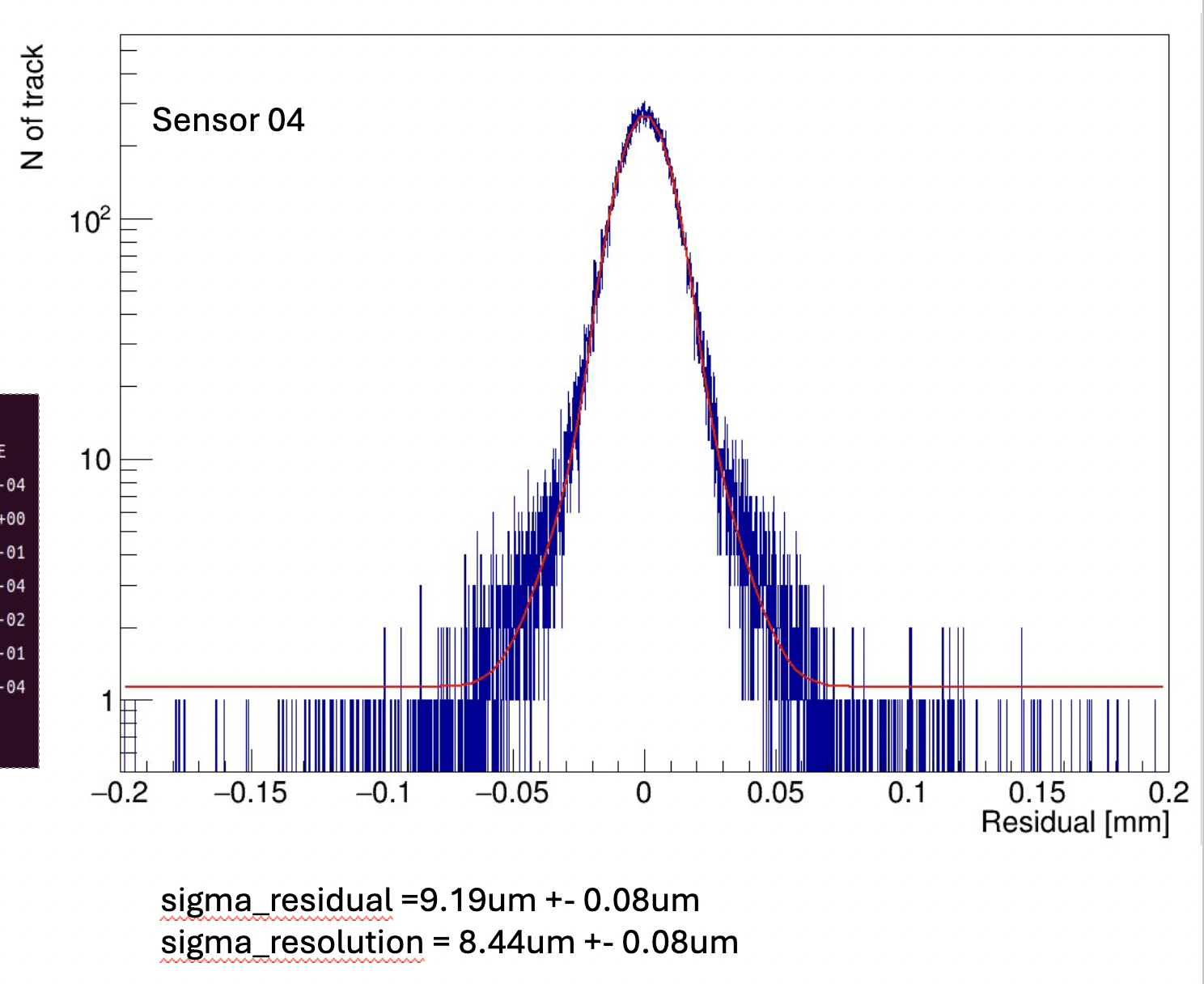
- bias resistor zone:
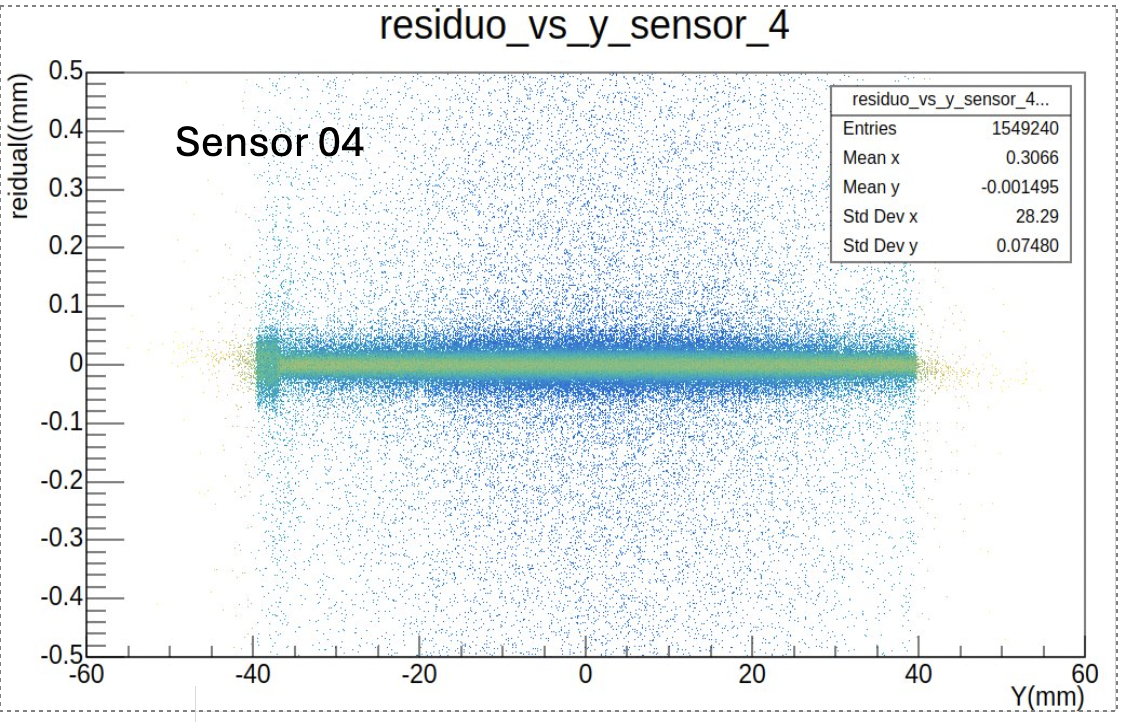
as expected in the region below the bias resistors, the resolution is worst;
H6: ATLAS MALTA (Please Put Your Name Here)
H8: STRAW TRACKER RD (Please Put Your Name Here)
AoB
Minutes by the respective speakers, edited by E. B. Holzer, M. Jäkel, T. Shulha, and M. Schwinzerl
There are minutes attached to this event.
Show them.
